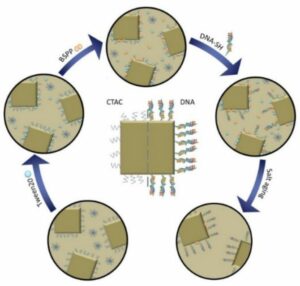- Home
- Research
- Nanobiophotonics
- Research results
- Plasmonic nanoparticle synthesis and functionalization
Plasmonic nanoparticle synthesis and functionalization

11.01.2023
Plasmonic nanoparticles have become important materials due to their special optical properties and development of optic and photonic technologies. In various application fields, such as plasmonic sensor technology, the shape anisotropic nanoparticles are of vast interest. That makes the synthesis of such structures to appear frequently in the focus of research. Gold nanoparticles are known demonstrate a low cytotoxicity, high stability, and unique optical properties with the ability of signal transduction of biological recognition events with enhanced analytical performance. The surface modification of such nanomaterials furnish them to become an integral part in various biomedical detection devices and nanotherapeutics for clinical diagnostics and disease control.
Colloidal nanomaterial synthesis frequently appears to be a sophisticated process requiring a fine balance of numerous parameters, for instance, temperature, incubation time, utilized reagents, and their concentration. Considering every factor makes it possible to form complex structures. Such studies were lately carried out by many research groups to obtain gold nanoparticles of various anisotropic shapes, such as rods, cubes, stars, triangles, etc. However, most of the procedures lack reproducibility or happen to be elaborate and time-consuming, which hinders a wide production and, hence, application of nanomaterials.
Recently, researchers at Leibniz IPHT have studied through the gold nanotriangle synthesis. Utilized online monitoring technique with Ultraviolet-visible (UV-Vis) spectroscopy in combination with the knowledge of the occurring chemical processes, allowed to rationally determine the time intervals required for successful reproduction of the procedure. As the result, the earlier reported procedure could be shortened from three days to one only (image above). This provides higher accessibility for a broad range of scientists and can serve as a starting point in streamlining nanoparticle production without sacrificing shape yield and reproducibility. The latter was proven with the characterization of the resulting samples using UV-Vis spectroscopy and scanning electron microscopy (SEM).
Strong electromagnetic field enhancements found in close proximity to the gold nanoparticle can be exploited to enhance signals for e. g., metal-enhanced fluorescence or Raman spectroscopy. Even stronger field enhancements can be achieved with sharp-edged nanoparticles such as nanocubes. Chemical surface modification and further bioconjugation are commonly used to reduce cytotoxicity, stabilize nanoparticles against aggregation, and increase the biocompatibility as well as specificity for analytical applications.
Our recent publication introduces a protocol to conjugate CTAC-capped gold nanocubes with thiol-modified DNA-oligonucleotides. The functionalization under mild biocompatible conditions allows the use of such conjugates for bioanalytical applications with high biocompatibility with a yield of 25%. The presented method combines a ligand-exchange reaction (using BSPP as the intermediate capping agent) with a salt-aging bioconjugation method (image below).

In the picture:
Schematic illustration of gold nanocube functionalization
The Zeta potential and LSPR-shift measurements of functionalized nanocubes were performed to confirm the successful surface modification. The colorimetric assay indicated increased colloidal stability of conjugates against aggregation in presence of NaCl and MgCl2 thanks to the additional charging of the DNA backbone and the steric shielding from the external environment. The mentioned salts are frequently essential in buffers for the assembly of DNA superstructures, which hold great potential for smart biosensing applications.
Funded by:
Deutsche Forschungsgemeinschaft (DFG),
Bundesministerium für Bildung und Forschung (BMBF)
In the image above:
Shape evolution of nanoparticles during gold nanotriangle synthesis.
